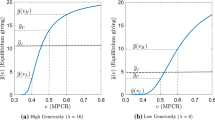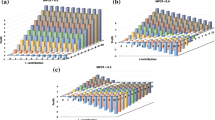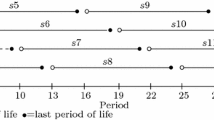Abstract
In a series of one-shot linear public goods game, we ask subjects to report their contributions, their contribution plans for the next period, and their first-order beliefs about their present and future partner. We estimate subjects’ preferences from plan data by a finite mixture approach and compare the results with those obtained from contribution data. Controlling for beliefs, which incorporate the information about the others’ decisions, we are able to show that plans convey accurate information about subjects’ preferences and, consequently, are good predictors of their future behavior.






Similar content being viewed by others
Notes
Survey questions are consequential if the “survey’s results are seen as potentially influencing an agency’s actions and the agent cares about the outcomes of those actions” (Carson and Groves 2007, p. 183).
We chose this protocol to minimize strategic effects from repeated play and to allow for revisions to beliefs only at the population level.
To simplify notation, we always refer to player \(i\)’s partner as \(j\), although this is a different person in each period.
A similar procedure for incentivizing subjects to state a carefully considered, truthful plan has been applied by Barkan and Busemeyer (1999).
When convenient, we will equivalently use the notation \(p_{\cdot ,t}^{t+1},\, t = 1, \ldots , 14\), to indicate contribution plans made in \(t\) for \(t+1\).
The instructions make clear that subjects have to predict the decisions of two different persons: the current-period partner (\(\mathbf{b}_{i,t}^{t}\)) and the next-period partner (\(\mathbf{b}_{i,t}^{t+1}\)).
To simplify presentation, players’ contributions in treatment \(C\) will be sometimes referred to as “final” even though no distinction between final and planned contributions is made in \(C\).
A similar rule has been used by, e.g., Offerman et al. (1996), Costa-Gomes and Weizsäcker (2008), and Rey-Biel (2009), although there exists no consensus among experimentalists about the optimal incentive mechanism for eliciting beliefs. Huck and Weizsäcker (2002) compare beliefs elicited via a quadratic scoring rule with beliefs elicited via a Becker-DeGroot-Marshak pricing rule, and find that the quadratic scoring rule yields more accurate beliefs.
The instructions are available from the authors upon request.
Because of our re-matching protocol, the numbers of statistically independent observations are 6 in \(C\), 5 in \(P_\mathrm{I}\), and 5 in \(P_{\mathrm{{NI}}}\).
In particular, the one-period-ahead and final expected contributions are computed, respectively, as
$$\begin{aligned} E_{i,t-1}[c_{j,t}] = \frac{\sum \nolimits _{a=0}^{10} \left( a\times 10\right) \times b_{i,t-1}^{t}\left( a\right) }{100} \qquad \text{ and } \qquad E_{i,t}[c_{j,t}] = \frac{\sum _{a=0}^{10} \left( a\times 10\right) \times b_{i,t}^{t}\left( a\right) }{100}. \end{aligned}$$To characterize the behavior of conditional cooperators, we could have used either a utility function à la Fehr and Smith (1999) or a different rule for \(Y_{j,t}\) like, e.g., the final (one-period-ahead) expected contribution. We opted for our simple rule for three reasons: (a) finding the functional form that fits the data best is not one of the objectives of this article; (b) we wanted for the conditional cooperator type a behavioral rule as straightforward as the one used for the other two types; (c) finally, but most importantly, our data analysis suggests that about 50 % of the contributions, both final and planned, comply with such a rule.
Nevertheless, identification fails to achieve in the following cases: when one of the modes of \(i\)’s distribution of beliefs always corresponds to \(a = 0\) and \(i\) always chooses to contribute 0 (in this case, a conditional cooperator is indistinguishable from a selfish subject); when one of the modes of \(i\)’s distribution of beliefs always corresponds to the median of \(i\)’s contributions and \(i\) always chooses to contribute exactly that amount (in that case, a conditional cooperator is indistinguishable from an altruist); when subjects change preferences over time.
To the best of our knowledge, this is the first time a tremble is estimated under such assumptions. We want the tremble probability to be individual-specific because this allows us to capture different kinds of behavior. There can be subjects who stick with their rule in all periods, subjects whose decisions are noisy at the beginning but not toward the end, and vice versa. Finally, there can be subjects whose decisions are extremely noisy throughout the entire game.
Details can be found in Train (2003).
In unreported analysis, we estimate the four models in Table 1 without time effects (i.e., constraining \(b_{1}\) and \(g_{1}\) to equal zero). Likelihood-ratio tests strongly reject the null hypothesis of no time effects (in all cases the \(p\)-values of the tests are \(<\)0.000). The regression results of these models are available from the authors upon request. We do not report the results here for two reasons: none of the conclusions concerning the main hypothesis under investigation changes when time effects are added to the mixture model; the models with time effects showed to be far superior on statistical grounds.
For this reason, we exclude six subjects from treatment \(P_{\mathrm{{NI}}}\).
References
Ambrus, A., & Pathak, P. A. (2011). Cooperation over finite horizons: A theory and experiments. Journal of Public Economics, 95(7,8), 500–512.
Anderson, S. P., Goeree, J. K., & Holt, C. A. (1998). A theoretical analysis of altruism and decision error in public goods games. Journal of Public Economics, 70(2), 297–323.
Andreoni, J. (1995). Cooperation in public-goods experiments: Kindness or confusion. American Economic Review, 85(4), 891–904.
Andreoni, J., & Miller, J. (2002). Giving according to GARP: An experimental test of the consistency of preferences for altruism. Econometrica, 70(2), 737–753.
Bardsley, N., & Moffatt, P. G. (2007). The experimetrics of public goods: Inferring motivations from contributions. Theory and Decision, 62(2), 161–193.
Barkan, R., & Busemeyer, J. R. (1999). Changing plans: Dynamic inconsistency and the effect of experience on the reference point. Psychonomic Bulletin & Review, 6(4), 547–554.
Bolton, G., & Ockenfels, A. (2000). ERC: A theory of equity, reciprocity and competition. American Economic Review, 90(1), 166–193.
Bone, J. D., Hey, J. D., & Suckling, J. R. (2003). Do people plan ahead? Applied Economics Letters, 10(5), 277–280.
Bone, J. D., Hey, J. D., & Suckling, J. R. (2009). Do people plan? Experimental Economics, 12(1), 12–25.
Carson, R. T., & Groves, T. (2007). Incentive and informational properties of preference questions. Environmental and Resource Economics, 37(1), 181–210.
Charness, G., & Rabin, M. (2002). Understanding social preferences with simple tests. Quarterly Journal of Economics, 117(3), 817–869.
Conte, A., & Hey, J. D. (2013). Assessing multiple prior models of behaviour under ambiguity. Journal of Risk and Uncertainty doi:10.1007/s11166-013-9164-x.
Costa-Gomes, M. A., & Crawford, V. P. (2006). Cognition and behavior in two-person guessing games: An experimental study. American Economic Review, 96(5), 1737–1768.
Costa-Gomes, M. A., & Weizsäcker, G. (2008). Stated beliefs and play in normal-form games. Review of Economic Studies, 75(3), 729–762.
Cox, J. C., Friedman, D., & Gjerstad, S. (2007). A tractable model of reciprocity and fairness. Games and Economic Behavior, 59(1), 17–45.
Croson, R. (2000). Thinking like a game theorist: Factors affecting the frequency of equilibrium play. Journal of Economic Behavior & Organization, 41(3), 299–314.
Croson, R. (2007). Theories of commitment, altruism and reciprocity: Evidence from linear public goods games. Economic Inquiry, 45(2), 199–216.
Echessah, P. N., Swallow, B. M., Kamara, D. W., & Curry, J. J. (1997). Willingness to contribute labor and money to tsetse control: Application of contingent valuation in Busia District, Kenya. World Development, 25(2), 239–253.
Edmunds, A., & Morris, A. (2000). The problem of information overload in business organisations: A review of the literature. International Journal of Information Management, 20(1), 17–28.
Fehr, E., & Schmidt, K. M. (1999). A theory of fairness, competition, and cooperation. Quarterly Journal of Economics, 114(3), 817–868.
Fischbacher, U. (2007). Zurich toolbox for readymade economic experiments. Experimental Economics, 10(2), 171–178.
Fischbacher, U., & Gächter, S. (2010). Social preferences, beliefs, and the dynamics of free riding in public good experiments. American Economic Review, 100(1), 541–556.
Fischbacher, U., Gächter, S., & Fehr, E. (2001). Are people conditionally cooperative? Evidence from a public goods experiment. Economics Letters, 71(3), 397–404.
Gabaix, X., Laibson, D., Moloche, G., & Weinberg, S. (2006). Costly information acquisition: Experimental analysis if a boundedly rational model. American Economic Review, 96(4), 1043–1068.
Gächter, S., & Renner, E. (2010). The effects of (incentivized) belief elicitation in public good experiments. Experimental Economics, 13(3), 364–377.
Greiner, B. (2004). An online recruitment system for economic experiments. In K. Kremer & V. Macho (Eds.), Forschung und wissenschaftliches Rechnen 2003 (pp. 79–93). Göttingen: GWDG Bericht 63, Ges. für Wiss. Datenverarbeitung.
Guimarães, P., & Lindrooth, R. C. (2007). Controlling for overdispersion in grouped conditional logit models: A computationally simple application of Dirichlet multinomial regression. Econometrics Journal, 10(2), 439–452.
Hausman, J., Hall, B. H., & Griliches, Z. (1984). Economic models for count data with an application to the patents-R &D relationship. Econometrica, 52(4), 909–938.
Hey, J. D. (2005). Do people (want to) plan? Scottish Journal of Political Economy, 52(1), 122–138.
Houser, D., & Kurzban, R. (2002). Revisiting kindness and confusion in public goods experiments. American Economic Review, 92(4), 1062–1069.
Huck, S., & Weizsäcker, G. (2002). Do players correctly estimate what others do? Evidence of conservatism in beliefs. Journal of Economic Behavior & Organization, 47(1), 71–85.
Kamuanga, M., Swallow, B. M., Sigué, H., & Bauer, B. (2001). Evaluating contingent and actual contributions to a local public good: Tsetse control in the Yale agro-pastoral zone, Burkina Faso. Ecological Economics, 39, 115–130.
Levine, D. K. (1998). Modeling altruism and spitefulness in experiments. Review of Economic Dynamics, 1(3), 593–622.
Loomes, G. (2005). Modelling the stochastic component of behaviour in experiments: Some issues for the interpretation of data. Experimental Economics, 8(4), 301–323.
Manski, C. F. (1990). The use of intentions data to predict behavior: A best-case analysis. Journal of the American Statistical Association, 85(412), 934–940.
Moffatt, P. G., & Peters, S. A. (2001). Testing for the presence of a tremble in economic experiments. Experimental Economics, 4(3), 221–228.
Morwitz, V. G. (1997). Why consumers don’t always accurately predict their own future behavior. Marketing Letters, 8(1), 57–70.
Offerman, T., Sonnemans, J., & Schram, A. (1996). Value orientations, expectations, and voluntary contributions in public goods. Economic Journal, 106(437), 817–845.
Offerman, T., Sonnemans, J., Van de Kuilen, G., & Wakker, P. P. (2009). A truth serum for non-Bayesians: Correcting proper scoring rules for risk attitudes. Review of Economic Studies, 76(4), 1461–1489.
Palfrey, T. R., & Prisbrey, J. E. (1996). Altruism, reputation and noise in linear public goods experiments. Journal of Public Economics, 61(3), 409–427.
Palfrey, T. R., & Prisbrey, J. E. (1997). Anomalous behavior in public goods experiments: How much and why? American Economic Review, 87(5), 829–846.
Rey-Biel, P. (2009). Equilibrium play and best response to (stated) beliefs in normal form games. Games and Economic Behavior, 65(2), 572–585.
Schnake, M. E. (1991). Equity in effort: The “sucker effect” in co-acting groups. Journal of Management, 17(1), 41–55.
Selten, R. (1998). Axiomatic characterization of the quadratic scoring rule. Experimental Economics, 1(1), 43–62.
Train, K. (2003). Discrete choice methods with simulation. Cambridge: Cambridge University Press.
Wilcox, N. T. (2007). Predicting risky choices out of context: A Monte Carlo study. University of Houston Working Paper.
Wilcox, N. T., & Feltovich, N. (2000). Thinking like a game theorist: Comment. University of Houston Department of Economics Working Paper.
Author information
Authors and Affiliations
Corresponding author
Appendix: Estimating expected beliefs
Appendix: Estimating expected beliefs
Here, we describe the rationale behind the econometric approach we use to estimate (from belief data) the expected probability that each alternative in \(\mathcal{A }\) is being chosen—referred to as “expected beliefs.” In this sense, it can be helpful to picture a subject with an urn containing colored balls. Each color corresponds to an alternative. The composition of the urn reflects the subject’s beliefs concerning his partner’s actions. When asked to report his beliefs, we can imagine that this subject draws 100 balls from his urn with replacement and reports the number of times each color/alternative has been drawn. At the end of each period, the composition of the urn is updated as a consequence of the new acquired information about the other’s action. We allow each subject to be characterized by his own urn. More technically, the composition of any of these urns can be interpreted as a point on a 10-simplex. Each urn is located in a different point of the simplex that reflects its composition, i.e., player’s beliefs.
We analyze data on beliefs with this picture in mind, and, consequently, we estimate the distribution of the different points (one for each player) on the 10-simplex. The natural choice to model a distribution over a simplex or the composition of an urn from which we observe several draws per subject (100 in the specific) is the Dirichlet-multinomial distribution. Hausman et al. (1984) and Guimarães and Lindrooth (2007) provide a full description of the distribution and the model estimated here. This distribution is characterized by the 11-dimensional vector of parameters \(\varvec{\lambda } \equiv (\lambda _{0}, \ldots , \lambda _{a}, \ldots , \lambda _{10})\) and has the nice and useful property that, for each alternative, the expected probability of being selected (expected belief) is
We can think of \(E[b_{a}]\) as the composition of the average urn. We use this property to estimate, period by period, the vector of parameters \(\varvec{\lambda }\) and to calculate the corresponding expected beliefs.
Figure 7 shows—separately for the two treatments—bar graphs of the proportion of times each alternative in \(\mathcal{A }\) has been chosen in periods 2 and 15, and superimposes on these bar graphs connected dots representing the expected probabilities that the others choose the corresponding alternative (as computed from belief data). In period 2, participants in both \(P_{\mathrm{{I}}}\) and \(P_{\mathrm{{NI}}}\) underestimate the probability that the others will choose extreme contributions (0 and 100). Inspection of the graphs for the last period demonstrates how the beliefs updating process is much slower in \(P_{\mathrm{{I}}}\) than in \(P_{\mathrm{{NI}}}\). In fact, while beliefs in \(P_{\mathrm{{NI}}}\) clearly incorporate the tendency of final contributions to move toward zero, beliefs in \(P_{\mathrm{{I}}}\) are still unable to capture about 50 % of the mass concentrated at the two extreme contributions.
The slower movements of beliefs in \(P_{\mathrm{{I}}}\) can also be appreciated in Fig. 8, displaying the time evolution of expected beliefs about current and future contributions separately for the two treatments. Each color represents an alternative and the associations color-alternative are listed in the legend located at the bottom. The two pairs of graphs look quite different. In \(P_{\mathrm{{NI}}}\), there is a clear tendency for \(E[b_0]\) to grow almost steadily over time and for the other expected beliefs to reduce. Conversely, in \(P_{\mathrm{{I}}}\), the real take-off of \(E[b_0]\) occurs around period 10 and the other expected beliefs patterns do not show any clear modification.
Rights and permissions
About this article
Cite this article
Conte, A., Levati, M.V. Use of data on planned contributions and stated beliefs in the measurement of social preferences. Theory Decis 76, 201–223 (2014). https://doi.org/10.1007/s11238-013-9365-4
Published:
Issue Date:
DOI: https://doi.org/10.1007/s11238-013-9365-4






